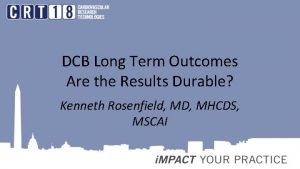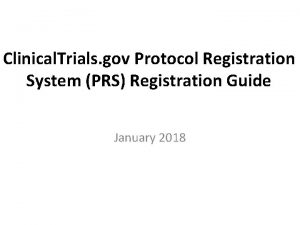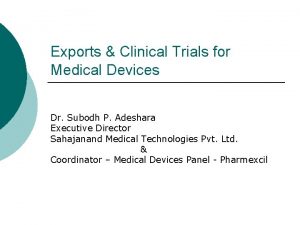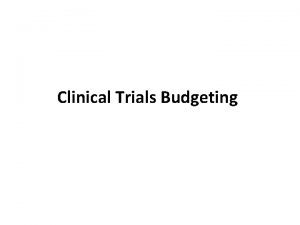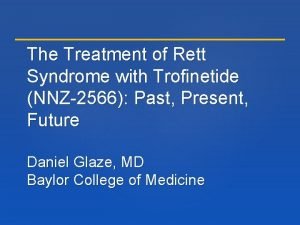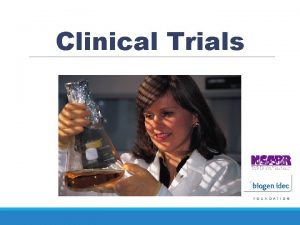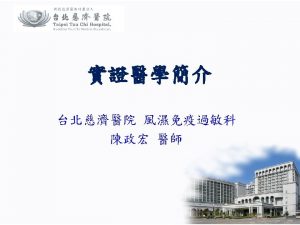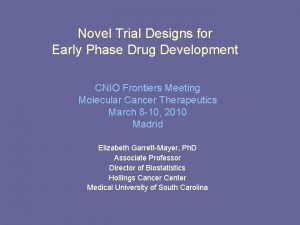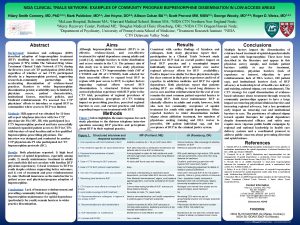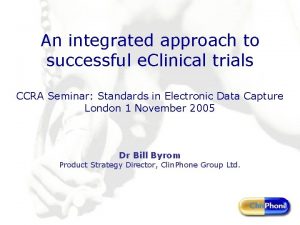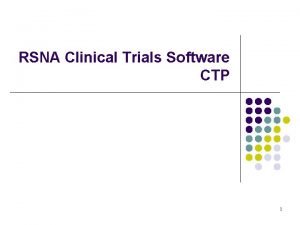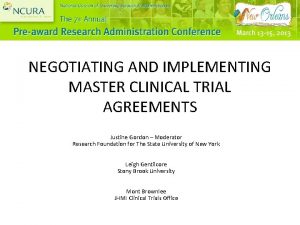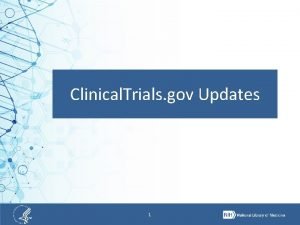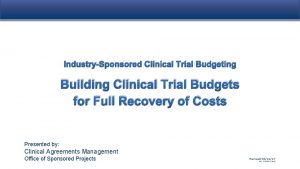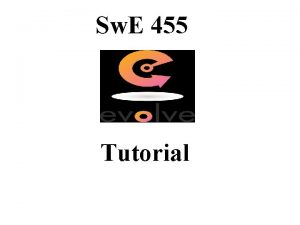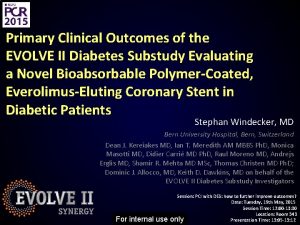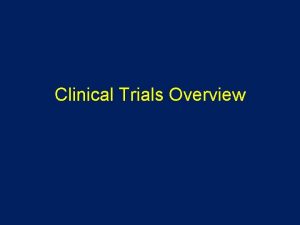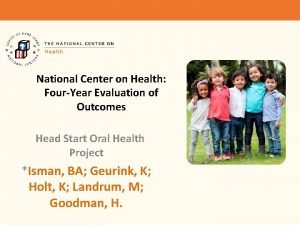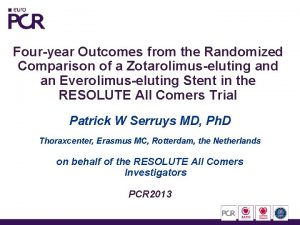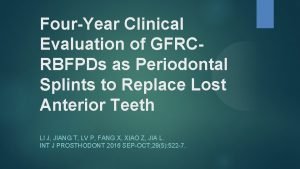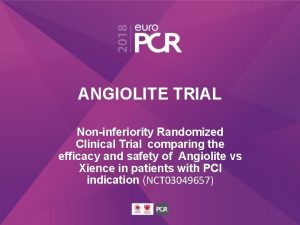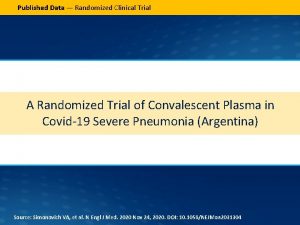Fouryear clinical outcomes in the EVOLVE trial A









![Death/MI/TVR 4 -year Follow-up PE vs SYNERGY HR 0. 86 [0. 36, 2. 08] Death/MI/TVR 4 -year Follow-up PE vs SYNERGY HR 0. 86 [0. 36, 2. 08]](https://slidetodoc.com/presentation_image_h2/f662571ab067c3192f972b37f7fd72ed/image-10.jpg)





- Slides: 15

Four-year clinical outcomes in the EVOLVE trial: A randomised evaluation of a novel bioabsorbable polymercoated, everolimus-eluting stent Ian T. Meredith, AM MBBS, Ph. D, FRACP, FCANZ, FSCAI, FAPSIC Professor and Director of Monash. Heart, Monash Health, Medical Centre & Monash University, Melbourne, Australia Stefan Verheye, Olivier Varenne, Raul Moreno, Seif El-Jack, Paul Barragan, Douglas Scott, Mariano Valdés, Nick West, Thomas Christen, Keith D. Dawkins, on behalf of the EVOLVE investigators Session: DES - Impact of biodegradable vs durable polymer on outcomes Date: Tuesday, May 19 th, 2015 Time: 13: 40 – 13: 47 For internal use only Location: Room 343

Disclosures § Honoraria for speaking/consultancy from Boston Scientific For internal use only

Introduction: Bioabsorbable polymer § Durable polymer coatings on drug-eluting stents have been associated with chronic inflammation and impaired healing. § Potential advantages of bioabsorbable polymer stents: § Reduced polymer load & short-term polymer exposure may: § Decrease risk of late events including ST and TLR § Reduce required duration of DAPT and risk if interrupted For internal use only

The SYNERGY Stent § Bioabsorbable polymer (PLGA) § Everolimus applied only to the abluminal surface (rollcoat) § Thin strut (74µm) platinum chromium stent Strut Cross Sections For internal use only PROMUS Element SYNERGY 81μm 74μm Arterial Wall

SYNERGY Stent Synchronous Drug Release & Polymer Absorption 100 75 75 50 50 25 25 0 0 30 60 Time (Days) Bennett and Dubois. Biologics: Targets and Therapy. 2013; 7: 149 -159. 90 120 For internal use only 0 Everolimus Releaesd (%) PLGA Mass Remaining (%) Kinetics of Drug Release and Polymer Absorption in a Preclinical Porcine Model

Trial Design and Methods Patients with de novo native coronary lesions ≤ 28 mm in length, RVD ≥ 2. 25 mm ≤ 3. 5, %DS>50 (excluded LM disease, CTO, AMI or recent MI) Randomized 1: 1: 1 at 29 sites (Europe, Australia, New Zealand) PROMUS Element N=98 SYNERGY N=94 SYNERGY ½ Dose N=99 Single-blind, noninferiority design Primary Clinical Endpoint: TLF (TV-CD, TV-MI, or TLR) at 30 days Primary Angiographic Endpoint: In-stent late loss at 6 months Per protocol patients were treated with clopidogrel, ticlopidine or prasugrel for at least 6 months following the index procedure Meredith et al. JACC 2012; 59 (15): 1362 -70

EVOLVE Primary Endpoint Late Loss at 6 Months P=0. 19* P=0. 56* Late loss, mm 0, 5 0, 4 0, 3 0, 2 0, 1 0, 0 0, 15 0, 10 PROMUS Element SYNERGY P=0. 49* 10, 0 Target Lesion Failure, % 0, 6 TLF at 30 days 0, 13 SYNERGY ½ Dose P=0. 25* 8, 0 6, 0 4, 0 2, 0 0 1, 1 PROMUS Element SYNERGY 3, 1 SYNERGY ½ Dose Noninferiority was proven because the upper 95. 2% confidence bound of the difference in 6 -month late loss is <0. 20 for both SYNERGY stents For internal use only Intent-to-treat; Mean + Standard Deviation; *P values for superiority comparison Meredith et al. JACC 2012; 59 (15): 1362 -70

Patient Disposition All Patients with de novo coronary lesions (ITT) N=291 PROMUS Element N=98 SYNERGY N=94 SYNERGY ½ Dose N=99 1 -year Follow-up N=98 1 -year Follow-up N=92 1 -year Follow-up N=95 2 -year Follow-up N=98 2 -year Follow-up* N=90 2 -year Follow-up N=93 3 -year Follow-up N=98 3 -year Follow-up* N=89 3 -year Follow-up N=95 4 -year Follow-up N=98/98 (100%) 4 -year Follow-up* N=88/92 (95. 7%) 4 -year Follow-up N=92/99 (92. 9%) *After 1 -year follow-up, the prespecified safety analysis patient population, including only those patients treated with a study stent, was analysed. Two SYNERGY patients who did not receive the study stent were not included in the safety analysis.

Target Lesion Failure 4 -year Follow-up PE vs SYNERGY HR 0. 76 [0. 24, 2. 40] P=0. 64 PE vs SYNERGY ½ HR 0. 73 [0. 23, 2. 31] P=0. 59 20 TLF, % Protocol-required angiogram 8. 4 5. 5 5. 2 0 Numbers at risk PE SYNERGY ½ Dose 0 1 2 3 4 Years 98 92 99 98 90 92 93 86 90 92 83 87 64 59 62 Safety Population; KM Event Rate; log-rank P values For internal use only
![DeathMITVR 4 year Followup PE vs SYNERGY HR 0 86 0 36 2 08 Death/MI/TVR 4 -year Follow-up PE vs SYNERGY HR 0. 86 [0. 36, 2. 08]](https://slidetodoc.com/presentation_image_h2/f662571ab067c3192f972b37f7fd72ed/image-10.jpg)
Death/MI/TVR 4 -year Follow-up PE vs SYNERGY HR 0. 86 [0. 36, 2. 08] P=0. 74 PE vs SYNERGY ½ HR 0. 93 [0. 40, 2. 20] P=0. 87 Death/MI/TVR, % 20 Protocol-required angiogram 12. 4 10. 4 9. 8 0 Numbers at risk PE SYNERGY ½ Dose 0 1 2 3 4 Years 98 92 99 96 90 92 89 84 88 88 81 84 62 58 60 Safety Population; KM Event Rate; log-rank P values For internal use only

Target Lesion Revascularisation 4 -year Follow-up PE vs SYNERGY HR 0. 18 [0. 02, 1. 47] P=0. 07 PE vs SYNERGY ½ HR 0. 17 [0. 02, 1. 74] P=0. 06 20 TLR, % Protocol-required angiogram 6. 1 1. 0 0 Numbers at risk PE SYNERGY ½ Dose 0 1 2 3 4 Years 98 92 99 98 90 95 93 87 93 92 84 90 64 59 63 Safety Population; KM Event Rate; log-rank P values For internal use only

4 -Year Clinical Outcomes 10 PROMUS Element Patients, % 8, 4 5 SYNERGY ½ Dose Components of TLF 5, 5 5, 2 6, 1 3, 3 3, 0 1, 1 1, 0 0 (7) (5) (6) (1) TLF TLR 1, 1 (2) (3) MI* (3) 0, 0 (1) 0, 0 Cardiac Death* Def/Prob ST Number of Events (N) Safety Population; KM Event Rates; All P values are >0. 05; *Target vessel-related For internal use only

4 -year Outcomes PROMUS Element n=98 SYNERGY n=92 P value SYNERGY ½ Dose n=99 P value 0. 0% (0) 5. 5% (5) 0. 02 4. 2% (4) 0. 04 - Cardiac 0. 0% (0) 1. 1% (1) 0. 29 1. 1% (1) 0. 30 - Non-cardiac 0. 0% (0) 4. 4% (4) 0. 04 3. 2% (3) 0. 08 3. 3% (2) 3. 3% (3) 0. 58 3. 0% (3) 0. 63 - Q-wave 0. 0% (0) Undef - Non-Q-wave 3. 3% (2) 3. 3% (3) 0. 58 3. 0% (3) 0. 63 All-cause death Any MI Safety Population; KM Event Rates, P values are versus PROMUS Element (Fisher exact test) For internal u

Deaths in EVOLVE Day (Post index procedure) Cause 191 Multiple injuries sustained in motor bike accident 364 Broken ribs and pneumothorax after a fall leading to respiratory failure 373 Diffuse metastatic breast carcinoma 472 Death due to unknown cause (considered a cardiac death) 577 Right lung carcinoma 593 Right middle cerebral artery infarct 678 Death due to unknown cause (considered a cardiac death) 777 Gastric cancer 825 Pancreatic cancer For internal use only

Conclusions and Significance § At 4 years, no significant differences were found between groups for TLF, cardiac death or MI Ø Trend toward lower rates of TLR with SYNERGY vs PROMUS Element Ø No incidence of definite/probable stent thrombosis in any group at 4 years § These results support the medium-term safety and efficacy of the novel abluminal bioabsorbable polymer SYNERGY everolimus-eluting stent for the treatment of patients with de novo coronary artery disease § Additional research is needed to evaluate clinical event rates and the potential for dual antiplatelet therapy reduction with this novel stent For internal use only
 Dcb clinical outcomes
Dcb clinical outcomes Clinical trial prs
Clinical trial prs Clinical trial exports
Clinical trial exports Clinical trial budget example
Clinical trial budget example Trofinetide clinical trial
Trofinetide clinical trial Phase 4 trial
Phase 4 trial Fsfd clinical trial
Fsfd clinical trial Clinical trial centers alliance
Clinical trial centers alliance Clinical trial worksheet
Clinical trial worksheet Novel clinical drug trial design
Novel clinical drug trial design Accelerated clinical trial agreement acta
Accelerated clinical trial agreement acta Nida clinical trials network
Nida clinical trials network Iwr clinical trials
Iwr clinical trials Ctp dicom
Ctp dicom Master clinical trial agreements
Master clinical trial agreements Clinicaltrials.gov api
Clinicaltrials.gov api
